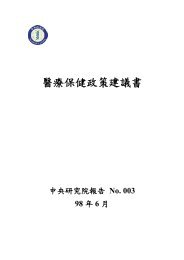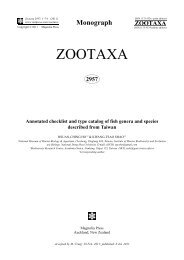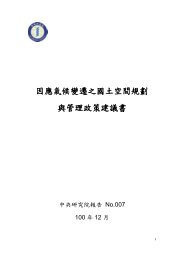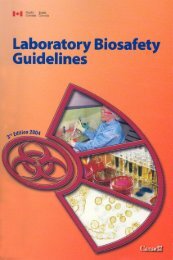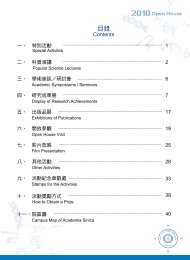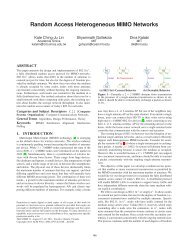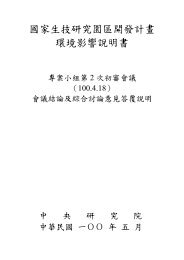Targeted Drug Delivery Systems Mediated by a ... - Academia Sinica
Targeted Drug Delivery Systems Mediated by a ... - Academia Sinica
Targeted Drug Delivery Systems Mediated by a ... - Academia Sinica
Create successful ePaper yourself
Turn your PDF publications into a flip-book with our unique Google optimized e-Paper software.
<strong>Targeted</strong> <strong>Drug</strong> <strong>Delivery</strong> to Breast Cancerability (Fig. 3 and 5). Second, targeted and sustained release ofthe drug molecules from encapsulated carriers can increasetherapeutic index of these chemotherapeutic agents against thetumor, while simultaneously reducing the toxicity of these drugson the normal tissues (Fig. 4); importantly, conjugation to SP90significantly reduced the toxicity of liposomal doxorubicin towhite blood cells (Fig. S2), one of the major adverse effects ofthis drug in the clinical setting [41]. Third, enhanced drugaccumulation in tumor tissues may help circumvent theproblems associated with delivering drugs to solid tumors withhigh interstitial fluid pressure (Fig. 5) [5,42,43]. Our resultsrevealed that SP90-LD more severely damaged blood vessels(data not shown) and cancer cells in tumor tissue as comparedto LD in therapeutic experiments (Fig. S5 and S6). However,we have no evidence to suggest that SP90 can bind vascularendothelial cells, and hence tumor vessels were most likely killedindirectly, as a result of the diffusion of small-molecule drugsfrom targeted cells to neighboring cells through the <strong>by</strong>standereffect.Although monoclonal antibodies have shown clinical benefits asanti-tumor agents, their potential for use as a drug delivery systemhas been limited due to a number of factors, including largemolecular size, poor tumor penetration, and high immunogenicitywhen used in immunoliposomes [44]. Additionally, antibodybaseddrug delivery may lead to higher than normal levels oftoxicity in liver and bone marrow, due to nonspecific antibodyuptake <strong>by</strong> Fc receptor-expressing normal cells [44]. Theselimitations can be overcome <strong>by</strong> using peptide ligands, which aresmaller, less immunogenic, and more cost-effective to produce andmanipulate [34,39]. Furthermore, multivalent peptide ligandshave only a moderate affinity to tumor antigens, which ispotentially advantageous for targeted drug delivery [26], sincethe strong affinity of antibodies may limit the penetration depth oftheir cargo into tumors [45,46].We found that most surgical specimens from breast cancerpatients could be detected <strong>by</strong> SP90-bearing phage, PC90 (Fig. 1and Table S1), further supporting the potential clinicalapplication of this novel peptide ligand. Conjugating pharmaceuticalnanocarriers or tumor imaging agents with SP90 mayimprove the effectiveness of current chemotherapeutic anddiagnostic options for human breast cancer, <strong>by</strong> increasing theirsensitivity and specificity. To explore whether the putativereceptor can recognize a peptide ligand with sequence of SP90,we performed Alignment Search for this 12-mer peptide usingBLASTP program [47]. No human protein sequences orconserved domains were found to be homologous to SP90based on our results. However, the targeted cell surfacemolecule recognized <strong>by</strong> SP90 needs to be identified, in orderto elucidate the mechanism of action of SP90 binding and toaddress safety concerns prior to clinical trials.In conclusion, we identified several novel peptides, includingSP90, capable of binding specifically to the cell surface of breastcancer cells both in vitro and in vivo. Linking SP90 to liposomescontaining doxorubicin increased the therapeutic efficacy in micewith human breast cancer xenografts, through enhanced tumorapoptosis and decreased tumor angiogenesis. Quantification andvisualization of doxorubicin levels also revealed increased drugconcentrations in tumor tissues targeted <strong>by</strong> the liposome,highlighting the enhancement in both delivery and penetrationof doxorubicin into the tumor. Our results indicate that the SP90peptide may be used to enable specific targeting of tumor cells inthe treatment of breast cancer, as well as to facilitate diagnosis ofthis malignancy.Supporting InformationFigure S1 Verification of binding and in vivo tumorhomingability of phages. a, The surface binding activity ofeach selected phage to breast cancer and NNM cells wasdetermined <strong>by</strong> flow cytometry. b, The binding activity of PC90phage to normal human mammary epithelial cells (HMEpiC) wasdetermined <strong>by</strong> flow cytometry. BT483 cells were used as positive.c, SCID mice bearing a BT483 xenograft tumor receivedintravenously injections of PC34, PC65, PC73, PC82, and controlhelper phage. After perfusion with PBS buffer, xenograft tumormasses and organs were removed and phage titers were measured.Phage titer in control organs are compared with tumor tissues, asindicated.(JPG)Figure S2 The low-magnification images of PC90 immunohistochemicalstaining in tumor-homing analysis(Fig. 1e). The PC90 phage was localized on tumor tissues and nolocalization was observed in normal organs such as the brain,heart, and lungs. Neither tumor cells nor normal organs werefound to have immunoreactivity with control phage.(JPG)Figure S3 Competition analysis of SP90-LD-inducedcytotoxic effect <strong>by</strong> free SP90 peptides. a, BT483 cells weretreated with various concentrations of LD or SP90-LD in thepresence of 10, 1, 0.1 or 0 mg/ml of SP90 peptides. b, BT483 cellswere incubated with free SP90 and control peptides at variousconcentrations. After incubation for three days, cell viability wasdetermined <strong>by</strong> MTT assay, and was calculated as a percentage ofliving cells. Each point represents the mean of three experiments.Error bar, s.d.(JPG)Figure S4 Response of SCID mice bearing BT483-derived xenografts to the administration of SP90-LD inFigure 3a. a, The effect of different treatments on white bloodcell (WBC) counts. SP90-LD reduced the WBC toxicity ofliposomal doxorubicin in the breast cancer xenograft model(n = 6 in each group; **P,0.001). b, The body weight of eachgroup. c, The effect of different treatments on change in bodyweight during the period from day 0 to day 20 (n = 6 in eachgroup).(JPG)Figure S5 Histopathological examination of SP90-LDtreatedbreast cancer xenografts. After cessation of treatment,PBS- and FD-treated tumors were removed on day 20,while LD- and SP90-LD-treated tumors were removed on day 32for histopathological examination. a, Tumor tissues were examinedafter staining with H&E. Markedly disseminated necrotic/apoptotic areas were observed throughout the entire section ofSP90-LD-treated xenografts. LD-treated xenografts presentedwith moderate necrotic/apoptotic areas, while normal breastcancer cells were observed in the FD- and PBS-treated groups.(Scale bar, 100 mm). b, The percentage areas of necrosis/apoptosis were determined (n=6) at low magnification. Theaverage percentage area of necrosis/apoptosis was markedlyincreased in the SP90-LD treated group as compared to theLD-, FD- or PBS-treated groups (n =6, **P,0.01).(JPG)Figure S6 SP90-conjugated targeting liposomes increasedtherapeutic efficacy through enhanced cancercell apoptosis. a, Sections were TUNEL-labeled to visualizeapoptotic tumor cells (green). TUNEL-positive tumor cells werePLOS ONE | www.plosone.org 11 June 2013 | Volume 8 | Issue 6 | e66128



